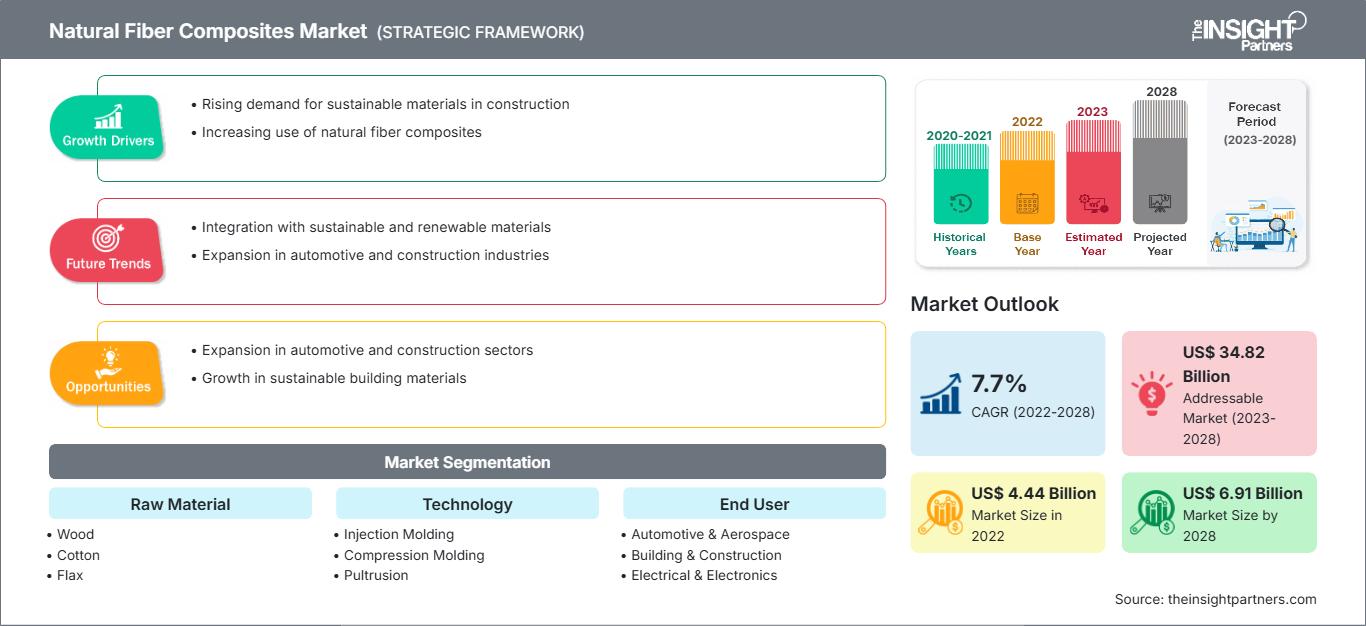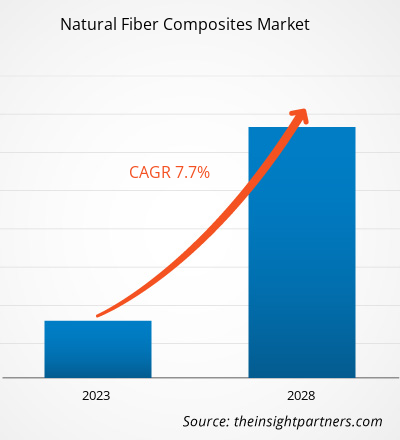Si prevede che il mercato dei compositi in fibra naturale crescerà da 4.438,83 milioni di dollari nel 2022 a 6.910,46 milioni di dollari entro il 2028; si stima che registrerà un CAGR del 7,7% dal 2022 al 2028.
I compositi in fibra naturale sono materiali compositi con una matrice polimerica incorporata con fibre naturali ad alta resistenza. Le fibre naturali sono utilizzate come componente di materiali compositi, dove l'orientamento delle fibre ne influenza le proprietà. Nei materiali compositi, il termine fibre naturali si riferisce spesso a fibre vegetali estratte da biomassa lignocellulosica come fibre di legno e altre fibre vegetali da stelo, foglia, frutto e seme.
La domanda di compositi rinforzati con fibre (fibre di vetro e carbonio) è relativamente elevata. Tuttavia, sono costosi e non sono ecocompatibili. Queste fibre non sono rinnovabili né riciclabili. Molti paesi dell'Unione Europea e asiatici hanno introdotto normative per l'industria automobilistica. Secondo la legislazione dell'Unione Europea approvata nel 2006, l'80% dei veicoli dovrebbe essere riutilizzato o riciclato; nella revisione del 2015, questa percentuale è salita all'85%. Secondo una normativa giapponese del 2015, il 95% dei veicoli dovrebbe essere riutilizzato o riciclato. Inoltre, svantaggi come l'elevata densità delle fibre, la scarsa riciclabilità e i rischi di manipolazione limitano l'uso dei compositi in fibra di vetro. Questi svantaggi dei compositi in fibra di vetro aumentano la domanda di compositi in fibra naturale.
Il mercato dei compositi in fibra naturale è segmentato in cinque regioni principali: Nord America, Europa, Asia-Pacifico, Medio Oriente e Africa e Sud e Centro America. Nel 2022, l'Europa detiene la quota di mercato maggiore e si stima che l'Asia-Pacifico registrerà il CAGR più elevato durante il periodo di previsione. L'elevata domanda di compositi in fibre naturali da parte dell'industria automobilistica e dell'edilizia favorisce la crescita del mercato europeo dei compositi in fibre naturali. Inoltre, l'Asia-Pacifico, la regione più popolata al mondo, ospita uno dei settori dell'edilizia e dell'automobile in più rapida crescita al mondo. Questo fattore contribuisce all'elevata domanda di compositi in fibre naturali nella regione.
Personalizza questo rapporto in base alle tue esigenze
Potrai personalizzare gratuitamente qualsiasi rapporto, comprese parti di questo rapporto, o analisi a livello di paese, pacchetto dati Excel, oltre a usufruire di grandi offerte e sconti per start-up e università
Mercato dei compositi in fibra naturale: Approfondimenti strategici

-
Ottieni le principali tendenze chiave del mercato di questo rapporto.Questo campione GRATUITO includerà l'analisi dei dati, che vanno dalle tendenze di mercato alle stime e alle previsioni.
Impatto della pandemia di COVID-19 sul mercato dei compositi in fibra naturale
Prima della pandemia di COVID-19, il mercato dei compositi in fibra naturale era trainato principalmente da settori come l'automotive, l'edilizia, gli articoli sportivi e la nautica. Nel 2020, diversi settori hanno dovuto rallentare le proprie attività a causa delle interruzioni nelle catene di approvvigionamento causate dalla chiusura dei confini nazionali e internazionali. La pandemia ha ostacolato i processi produttivi a causa delle restrizioni imposte dalle autorità governative di diversi paesi. I compositi rinforzati con fibre naturali trovano importanti applicazioni nell'industria aerospaziale e automobilistica, dove vengono utilizzati per gestire il peso dei veicoli e il carburante. Vengono utilizzati in pasta cementizia e malta nel settore edile. Pertanto, con la riduzione dell'attività in questi settori, anche la domanda di compositi in fibra naturale è diminuita. La pandemia ha anche causato fluttuazioni nei prezzi delle materie prime. Tutti questi fattori hanno portato a una diminuzione della domanda di compositi in fibra naturale.
Tuttavia, nel 2021, le economie hanno iniziato a riprendersi con la ripresa delle attività commerciali in diversi settori. Di conseguenza, diversi settori, tra cui quello automobilistico e quello dell'edilizia, hanno mostrato segnali di ripresa. Diversi settori stanno inoltre superando le conseguenze delle interruzioni nelle catene di approvvigionamento delle materie prime. Con una ripresa così promettente, si prevede che il settore industriale globale fornirà l'impulso alla crescita del mercato dei compositi in fibra naturale nei prossimi anni.
Approfondimenti di mercato
Gli sviluppi strategici dei principali attori favoriscono la crescita del mercato dei compositi in fibra naturale
A luglio 2022, il BMW Group, la società di venture capital della casa automobilistica premium, ha investito in Bcomp Ltd, un'azienda svizzera di clean tech, produttrice di componenti ad alte prestazioni realizzati con fibre naturali. Si prevede che tali sviluppi strategici da parte dei principali attori rafforzeranno la crescita del mercato dei compositi in fibra naturale nei prossimi anni. Inoltre, i principali attori del mercato sono coinvolti in strategie come fusioni e acquisizioni per espandere la propria presenza geografica.
Approfondimenti basati sulle materie prime
In base alla materia prima, il mercato dei compositi in fibre naturali è segmentato in legno, cotone, lino, kenaf, canapa e altri. Si prevede che il segmento della canapa registrerà il CAGR più elevato durante il periodo di previsione. Le fibre di canapa si trovano nel fusto della pianta, il che le rende resistenti. Sono essenziali per il rafforzamento dei materiali compositi. Con la crescente domanda di materiali sostenibili, biodegradabili e riciclabili, l'uso di fibre di canapa come supporto nei materiali compositi è aumentato. I compositi in fibre naturali realizzati con la canapa sono biodegradabili.
Approfondimenti basati sull'utente finale
In base all'utente finale, il mercato dei compositi in fibre naturali è suddiviso in settori automobilistico e aerospaziale, edilizia e costruzioni, elettrico e Elettronica, articoli sportivi e altri. Il segmento automobilistico e aerospaziale ha dominato il mercato nel 2022. I compositi in fibre naturali sono ampiamente utilizzati nella fabbricazione di componenti per auto elettriche grazie alla loro leggerezza. Grazie alla loro maggiore rigidità e resistenza rispetto ad altre fibre sintetiche e alle migliori proprietà di isolamento acustico, questi compositi vengono impiegati anche nei pannelli delle portiere, negli schienali dei sedili, nei pannelli del pavimento, nei pannelli sottoscocca e nei rivestimenti del bagagliaio.
UPM-Kymmene Corp, Flexform Technologies LLC, Polyvlies Franz Beyer GmbH, Amorim Cork Composites SA, Tecnaro GmbH, Lanxess AG, Bcomp Ltd, Cobra Advanced Composites Co Ltd, Plasthill Oy Ltd e Lingrove Inc sono tra i principali attori che operano nel mercato dei compositi in fibre naturali. Queste aziende si concentrano principalmente sull'innovazione di prodotto per espandere la propria quota di mercato e seguire le tendenze emergenti.
Approfondimenti regionali sul mercato dei compositi in fibra naturale
Le tendenze regionali e i fattori che influenzano il mercato dei compositi in fibra naturale durante il periodo di previsione sono stati ampiamente spiegati dagli analisti di The Insight Partners. Questa sezione illustra anche i segmenti e la geografia del mercato dei compositi in fibra naturale in Nord America, Europa, Asia-Pacifico, Medio Oriente e Africa, America meridionale e centrale.
Ambito del rapporto di mercato sui compositi in fibra naturale
| Attributo del rapporto | Dettagli |
|---|---|
| Dimensioni del mercato in 2022 | US$ 4.44 Billion |
| Dimensioni del mercato per 2028 | US$ 6.91 Billion |
| CAGR globale (2022 - 2028) | 7.7% |
| Dati storici | 2020-2021 |
| Periodo di previsione | 2023-2028 |
| Segmenti coperti |
By Materia prima
|
| Regioni e paesi coperti |
Nord America
|
| Leader di mercato e profili aziendali chiave |
|
Densità degli attori del mercato dei compositi in fibra naturale: comprendere il suo impatto sulle dinamiche aziendali
Il mercato dei compositi in fibra naturale è in rapida crescita, trainato dalla crescente domanda degli utenti finali, dovuta a fattori quali l'evoluzione delle preferenze dei consumatori, i progressi tecnologici e una maggiore consapevolezza dei vantaggi del prodotto. Con l'aumento della domanda, le aziende stanno ampliando la propria offerta, innovando per soddisfare le esigenze dei consumatori e sfruttando le tendenze emergenti, alimentando ulteriormente la crescita del mercato.

- Ottieni il Mercato dei compositi in fibra naturale Panoramica dei principali attori chiave
In evidenza nel rapporto
- Tendenze progressive del settore nel mercato dei compositi in fibra naturale per aiutare le aziende a sviluppare strategie efficaci a lungo termine
- Strategie di crescita aziendale adottate dagli operatori del mercato nei paesi sviluppati e in via di sviluppo
- Analisi quantitativa del mercato dei compositi in fibra naturale dal 2020 al 2028
- Stima della domanda globale di compositi in fibra naturale
- Analisi delle cinque forze di Porter per illustrare l'efficacia di acquirenti e fornitori che operano nel settore dei compositi in fibra naturale
- Sviluppi recenti per comprendere lo scenario competitivo del mercato
- Tendenze e prospettive di mercato, nonché fattori che guidano e frenano la crescita del mercato dei compositi in fibra naturale
- Assistenza nel processo decisionale evidenziando le strategie di mercato che sostengono l'interesse commerciale
- Dimensioni del mercato dei compositi in fibra naturale in vari nodi
- Panoramica dettagliata e segmentazione del mercato e dinamiche di crescita del settore dei compositi in fibra naturale
- Dimensioni del mercato dei compositi in fibra naturale in varie regioni con promettenti opportunità di crescita
- Analisi storica (2 anni), anno base, previsione (7 anni) con CAGR
- Analisi PEST e SWOT
- Valore/volume delle dimensioni del mercato - Globale, Regionale, Nazionale
- Industria e panorama competitivo
- Set di dati Excel
Report recenti
Rapporti correlati
Testimonianze
Motivo dell'acquisto
- Processo decisionale informato
- Comprensione delle dinamiche di mercato
- Analisi competitiva
- Analisi dei clienti
- Previsioni di mercato
- Mitigazione del rischio
- Pianificazione strategica
- Giustificazione degli investimenti
- Identificazione dei mercati emergenti
- Miglioramento delle strategie di marketing
- Aumento dell'efficienza operativa
- Allineamento alle tendenze normative






















 Ottieni un campione gratuito per - Mercato dei compositi in fibra naturale
Ottieni un campione gratuito per - Mercato dei compositi in fibra naturale